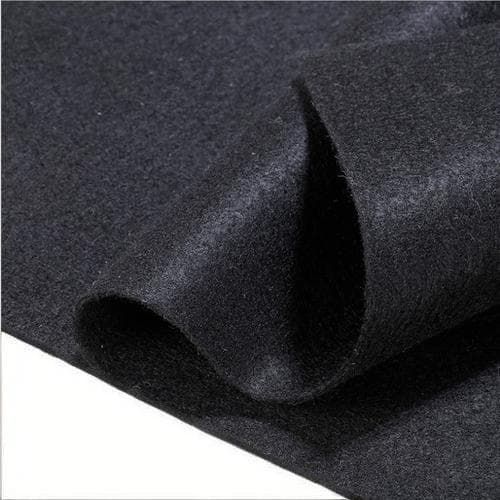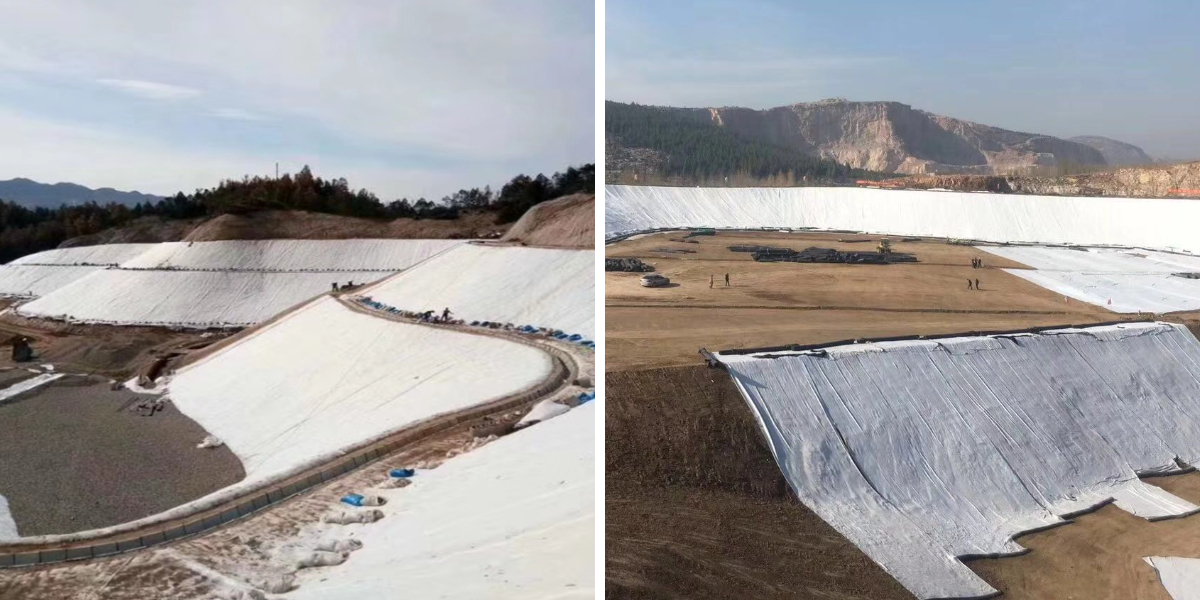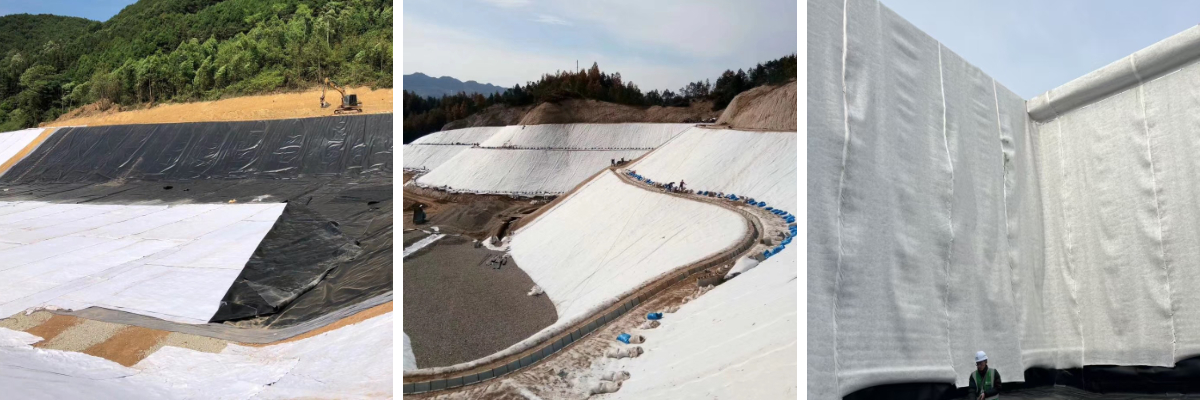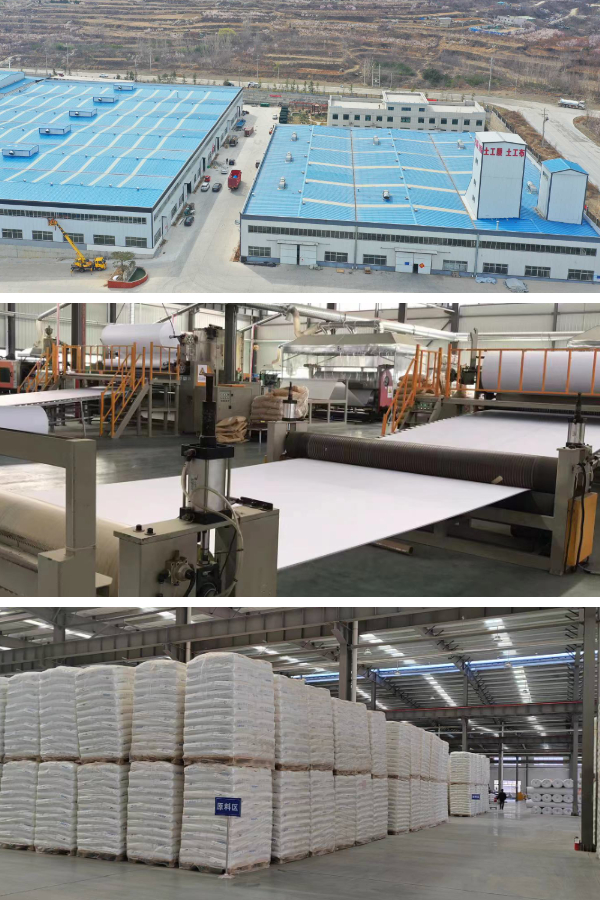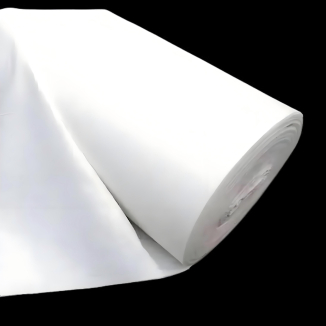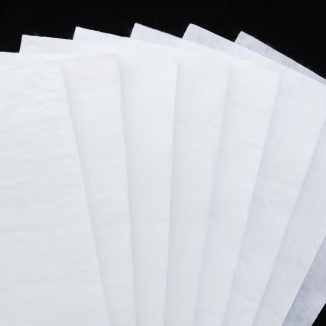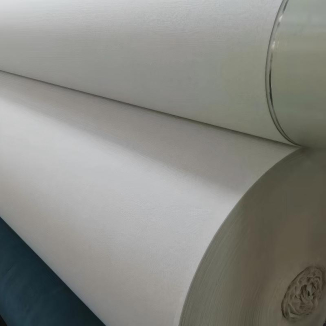Geotextile 120 gsm
1. Reliable protection: As an isolation layer, it prevents different soil layers (such as roadbed and soft soil) from mixing with each other and maintains material integrity; As a buffer layer, it resists external damage such as water flow erosion.
2. Excellent drainage: With good permeability, it can quickly drain accumulated water inside the soil, effectively reduce pore water pressure, enhance structural stability, and replace some complex sand and gravel drainage layers.
3. Persistent filtration: allowing water to pass freely while effectively preventing excessive loss of soil particles, preventing piping and erosion, with long-lasting and stable performance.
4. Corrosion resistance and durability: Made of synthetic fibers, it is resistant to acid, alkali, insect infestation, and microbial corrosion, and has a long service life
Product Introduction:
Geotextile 120 gsm is a permeable geosynthetic material made from synthetic fibers (such as polypropylene, polyester, nylon, etc.) through processes such as needle punching, weaving, or spinning. It looks like ordinary cloth in appearance, but has engineering characteristics such as high strength, corrosion resistance, aging resistance, and good water permeability. It is widely used in various fields such as civil engineering, water conservancy engineering, and environmental engineering, and is known as the "textile in civil engineering".
Main functions
Geotextiles mainly play the following roles in engineering, and often one type of geotextile has multiple functions at the same time:
Isolation function:
Principle: Separate two types of soil or materials with different particle sizes (such as roadbed and soft foundation, gravel and soft soil).
Function: To prevent materials from different layers from mixing with each other, maintain their structural integrity and bearing capacity, prevent weak foundation soil from invading the gravel base, and prevent roadbed failure.
Filtering function:
Principle: Allow water flow to pass vertically through the fabric, while effectively intercepting and preventing excessive loss of soil particles.
Function: Commonly used around drainage structures, such as blind ditches and drainage pipe wrapping layers, to prevent soil from being washed away by water flow and ensure the smooth operation of the drainage system.
Drainage function:
Principle: Geotextile itself is a permeable layer that can form drainage channels within its plane, allowing liquids and gases to be discharged along its plane direction.
Function: Used for drainage inside earth dams and retaining walls, or as a horizontal drainage layer in soft foundation treatment.
Reinforcement function:
Principle: By utilizing its high tensile strength and toughness, it disperses the load, limits the lateral displacement of the soil, and thus improves the overall stability and bearing capacity of the soil.
Function: Used to reinforce soft soil foundations, enhance the stability of steep slopes and retaining walls.
Protective function:
Principle: As a buffer layer, it dissipates or reduces the damage of external stress (such as water flow erosion, rockfall impact) to the soil.
Function: Used for anti erosion protection of riverbanks and coasts, as well as for protecting anti-seepage layers in landfills.
Anti leakage function (usually referring to composite geomembrane):
Principle: A layer of plastic film (such as HDPE, LDPE) is compounded on the geotextile to form a composite geotextile film, which becomes an impermeable barrier.
Function: Mainly used for anti-seepage of reservoirs, dams, channels, landfills, and tailings ponds.
Main Categories
According to different manufacturing processes and structures, geotextiles are mainly divided into the following categories:
Manufacturing process: It is mainly composed of short fibers or long fibers arranged randomly through needle punching or thermal bonding methods.
Features: The appearance is fluffy, with good isotropy, high porosity, and strong permeability. Has good filtering, isolation, and drainage functions.
Application: It is currently the most widely used and widely used type of geotextile.
Manufacturing process: Two or more sets of yarns or filaments are interwoven with each other on a weaving machine according to a certain pattern.
Characteristics: Dense structure, uniform pores, high tensile strength, high modulus, low elongation.
Application: Mainly used for reinforcement and strengthening projects, especially in situations where high strength is required.
Manufacturing process: It is formed by bending one or more yarns into loops and interlocking them with each other.
Characteristics: Relatively few applications, with specific mechanical properties.
Main technical indicators
When choosing geotextiles, it is important to pay attention to the following key physical and mechanical performance indicators:
Unit area mass: The weight per square meter is the basic indicator.
Thickness: The thickness under a specific pressure.
Tensile strength: The longitudinal and transverse fracture strength is the key to the reinforcement function.
Tensile elongation at break: the percentage of elongation at break.
CBR top breaking strength: simulates the ability of coarse-grained materials to break through fabrics, reflecting their resistance to damage.
Equivalent aperture: reflects the filtering performance of geotextile, that is, the size of soil particles that can be effectively intercepted.
Vertical permeability coefficient: reflects the permeability in the vertical direction.
Tear strength: the ability to resist tearing and expansion.
Product Parameters:
project | metric | ||||||||||
Nominal strength/(kN/m) | |||||||||||
6 | 9 | 12 | 18 | 24 | 30 | 36 | 48 | 54 | |||
1 | Longitudinal and transverse tensile strength / (kN/m) ≥ | 6 | 9 | 12 | 18 | 24 | 30 | 36 | 48 | 54 | |
2 | Maximum elongation at maximum load in longitudinal and transverse directions/% | 30~80 | |||||||||
3 | CBR top penetration strength /kN ≥ | 0.9 | 1.6 | 1.9 | 2.9 | 3.9 | 5.3 | 6.4 | 7.9 | 8.5 | |
4 | Longitudinal and transverse tearing strength /kN | 0.15 | 0.22 | 0.29 | 0.43 | 0.57 | 0.71 | 0.83 | 1.1 | 1.25 | |
5 | Equivalent aperture O.90(O95)/mm | 0.05~0.30 | |||||||||
6 | Vertical permeability coefficient/(cm/s) | K× (10-¹~10-), where K=1.0~9.9 | |||||||||
7 | Width deviation rate /% ≥ | -0.5 | |||||||||
8 | Unit area mass deviation rate /% ≥ | -5 | |||||||||
9 | Thickness deviation rate /% ≥ | -10 | |||||||||
10 | Thickness coefficient of variation (CV)/% ≤ | 10 | |||||||||
11 | Dynamic perforation | Puncture hole diameter/mm ≤ | 37 | 33 | 27 | 20 | 17 | 14 | 11 | 9 | 7 |
12 | Longitudinal and transverse fracture strength (grab method)/kN ≥ | 0.3 | 0.5 | 0.7 | 1.1 | 1.4 | 1.9 | 2.4 | 3 | 3.5 | |
13 | Ultraviolet resistance (Xenon arc lamp method) | Longitudinal and transverse strength retention rate% ≥ | 70 | ||||||||
14 | Ultraviolet resistance (fluorescence UV lamp method) | Longitudinal and transverse strength retention rate% ≥ | 80 | ||||||||
Product Applications:
1. Water Conservancy and Hydropower Projects
Dam Projects:
Dam Body Filter Layer: Non-woven geotextiles are laid on the water-facing slope of the dam or between the dam fill and the sand and gravel filter material to trap soil particles and allow water to pass through, preventing soil loss from the dam body.
Dam Foundation Drainage: Geotextiles are laid at the base of the dam foundation to accelerate the drainage of seepage water, reduce pore water pressure in the foundation, and prevent dam body subsidence.
Slope Protection: Geotextiles are laid on the dam slopes and covered with stone blocks or precast concrete blocks to disperse water flow and prevent slope erosion and collapse. River and Canal Engineering:
Slope restoration after dredging: Geotextiles are laid to stabilize the soil on the slopes, preventing further erosion and the spread of silt. Aquatic plants can also be planted on the geotextiles for ecological protection.
Irrigation channel lining: A "geotextile + geomembrane" composite structure is laid on the channel bottom and slopes. The geotextile protects the geomembrane from soil particles and debris, while also assisting drainage and preventing channel leakage. Reservoirs and Hydropower Stations:
Reservoir Bank Protection: Geotextiles are laid in landslide-prone areas of the reservoir bank to enhance soil integrity and reduce erosion caused by water level fluctuations.
2. Transportation Infrastructure Projects
Highway/Railway Subgrade:
Soft Subgrade Treatment: High-tensile-strength woven or filament geotextiles are laid on the surface of soft subgrade, followed by gravel or earth filling. The tensile strength of the geotextiles is used to restrain lateral displacement of the subgrade soil and reduce subgrade settlement.
Subgrade Isolation: Geotextiles are laid between the subgrade fill and the gravel layer, or between the subgrade and bridge abutments, to prevent soil particles from seeping into the gravel gaps and causing subgrade hardening. This also mitigates differential deformation between different materials.
Pavement Maintenance: When renovating existing pavement, geotextiles are laid between the old asphalt layer and the new base layer to reduce bond failure between the new and old layers and delay pavement cracking. Airport Runway:
Runway Base Reinforcement: Geotextiles are laid between the runway's gravel base and the soil foundation to strengthen the base's integrity, resist concentrated loads from aircraft takeoff and landing, and reduce runway settlement and deformation.
Drainage Layer Support: Geotextiles are laid in the runway's side drainage ditches to filter sediment carried by rainwater and prevent clogging.
Ports and Waterways:
Wharf Yard Foundation: Geotextiles are laid on the soft soil foundation of the wharf's cargo storage area to increase the foundation's bearing capacity and prevent yard settlement.
Waterway Dredging Protection: Geotextiles are laid on waterway slopes to prevent erosion of dredged soil and ensure stable waterway depth.
3. Environmental Protection Projects
Landfills:
Impermeable System Protection Layer: A non-woven geotextile is laid above the HDPE impermeable membrane at the bottom of the landfill to prevent sharp objects from piercing the membrane. A geotextile is also laid beneath the membrane to isolate the membrane from the soil and prevent soil particles from damaging the membrane structure.
Leachate Drainage: A geotextile is laid between the impermeable membrane and the waste layer to facilitate leachate drainage through blind drains, preventing leachate retention.
Site Covering: After the landfill is filled, a geotextile is laid on the surface of the waste, followed by a covering layer of soil and vegetation to isolate the waste from the surface environment, preventing odor spread and excessive rainwater infiltration.
Sewage Treatment and Solid Waste Disposal:
Sewage Treatment Plant Sedimentation Tanks: A geotextile is laid at the bottom of the sedimentation tank to isolate the tank concrete from the underlying soil, preventing soil impurities from seeping into the wastewater and assisting with drainage.
Hazardous Waste Landfills: Geotextiles are used in conjunction with high-strength impermeable membranes to enhance the safety of the impermeable system and prevent harmful substances from hazardous waste from leaching into groundwater. Ecological Restoration Projects:
Contaminated Soil Remediation: Geotextiles are laid on the surface of contaminated soil, followed by a clean soil layer to isolate the contaminated soil from plant roots and prevent pollutants from being absorbed by plants.
Mine Reforestation: Geotextiles are laid on exposed slopes after mining to stabilize the gravel and soil, followed by spraying with vegetation to achieve slope greening and prevent soil erosion.
4. Municipal and Construction Engineering
Sponge City Construction:
Permeable Pavement Sublayer: Geotextiles are laid beneath permeable asphalt/concrete pavement to isolate the pavement material from the roadbed soil, allowing rainwater to infiltrate through the pavement into the geotextile layer and then drain into underground reservoirs through drainage blind pipes, while preventing soil particles from clogging the permeable pores.
Sunken Green Spaces: Geotextiles are laid beneath the soil layer of green spaces to control the rate of rainwater infiltration, prevent waterlogging in the green spaces, and protect the underground drainage network from silt and sand blockage. Underground Space Engineering (Subway, Tunnels):
Subway Tunnel Waterproofing: Geotextiles are laid on the outside of tunnel segments as a protective layer for the waterproofing membrane, preventing damage from sharp edges in the segment concrete or soil particles. This also assists in draining water from the tunnel perimeter.
Underground Pipeline Corridors: Geotextiles are laid between the corridor foundation and the soil to isolate the foundation from the soil, reduce the impact of soil settlement on the corridor structure, and assist with drainage.
Building and Community Engineering:
Rooftop Greening: Geotextiles are laid above the rooftop waterproofing layer to isolate the waterproofing layer from the planting soil, preventing roots in the planting soil from piercing the waterproofing layer. This also assists with drainage and prevents water accumulation on the rooftop.
Community Road Subgrade: Geotextiles are laid on the soft soil foundation of community branch roads to enhance the roadbed's bearing capacity and prevent road subsidence and cracking due to vehicle traffic.
5. Agriculture and Forestry Engineering
Farmland Water Conservancy:
Terrace Protection: Geotextiles are laid along the ridges and slopes of mountain terraces to prevent rainwater from eroding the terraced soil and maintain their stability.
Farmland Drainage Channels: Geotextiles are laid along the inner walls of drainage channels to prevent soil collapse and blockage, while also accelerating the drainage of accumulated water from farmland.
Forestry and Orchards:
Forest Slope Stabilization: Geotextiles are laid on steep slopes during the conversion of farmland to forest to stabilize the topsoil, promote root growth, and prevent soil erosion.
Orchard Weed Control: Geotextiles are laid on the surface of orchards to isolate the soil from weeds, reducing weed growth while allowing rainwater to infiltrate the soil and prevent waterlogging.



